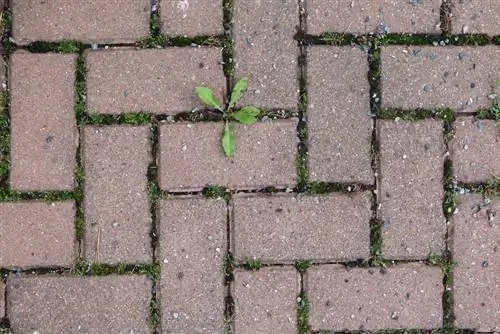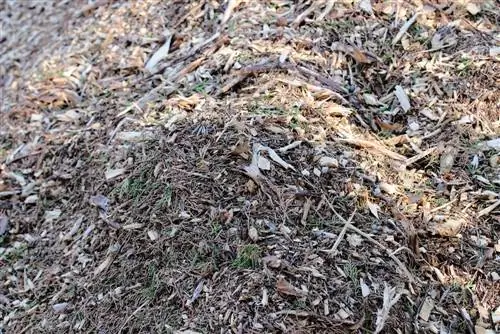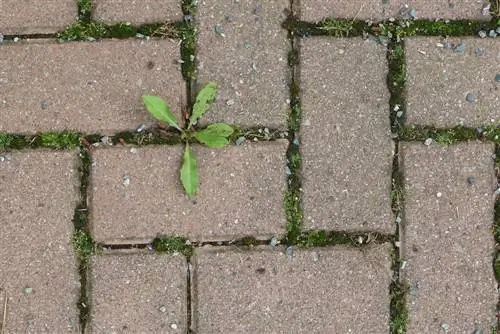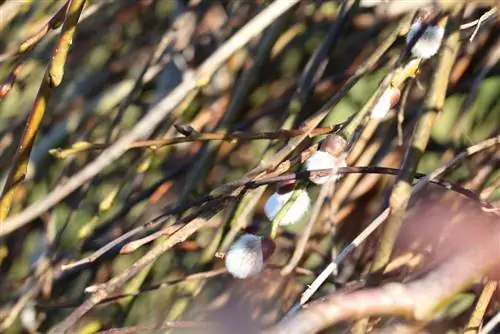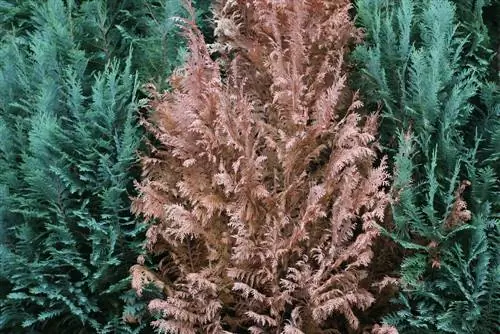- Author admin [email protected].
- Public 2023-12-17 03:39.
- Last modified 2025-01-24 12:45.
Flamming is not a new technique. Flaming devices have been used in organic farms since 1852. However, these primitive devices based on petroleum or gasoline still had difficulty ensuring a stable flame. In 1948, effective designs based on liquid gas came onto the market for the first time. Since then, the equipment used primarily in vegetable cultivation has continued to be developed. And modern hand-held devices have also been available for household use for several years and are becoming increasingly popular.
How it works
When flaming, the plant or plant parts are generally not burned. The weeds are simply heated to relatively high temperatures using a burner. When plant cells are heated to 60 to 70 degrees for a period of just about a second, the protein that each cell contains coagulates. If the plant parts are suddenly heated to around 110 degrees, the cell walls burst and the cell fluid escapes. The weeds do not have to be burned completely so that the plant dries up and dies. These temperatures can be reached without any problems when burning liquid gas, which flame devices are currently used with. Propane gas develops heat more quickly than butane gas, which is why it is better suited for weed destruction by flaming.
Areas of application
Over time, various plants settle on paved and paved surfaces. Mostly these are dandelions and annual panicles. But creeping knotweeds and plantains are also not uncommon. Mosses can be found in shady areas. Not only do the weeds look unsightly, they can also cause safety problems for pedestrians and cyclists on sidewalks. Willow or birch seedlings sometimes even lift the panels with their strong roots and can also cause damage to the building structure.
Legal basis
Since the use of plant protection products on sidewalks and paved areas such as terraces and garage entrances is prohibited, in addition to the obligatory, laborious and time-consuming weeding, in which the plants and mosses have to be scraped out of the joints with a knife, for example The burning method is increasingly being used in the private sector. This thermal method is very energy-consuming and therefore expensive. Flaming therefore only makes sense if mechanical measures are not an option or if the areas are smaller.
§ 12 of the Plant Protection Act states:
Unwanted grasses and herbs in squares and paths should be removed mechanically or thermally. Various devices and procedures are available for this purpose, for which no special approval is required. The permitted thermal processes include devices that work according to the following principle:
- Combustion of gas or oil (hot gas mixture)
- Infrared radiation
- heated water or steam
- hot air
These devices also include all types of flame devices designed for domestic use for weed control.

Effectiveness
Under ideal conditions, weed removal is very efficient. However, the effect of this method is very variable and depends on a variety of factors. These include, for example:
- Number of weeds
- Type of plants
- Size (the smaller, the more effective)
- Weather conditions
Since the roots are not affected by thermal methods, just like most mechanical methods, multiple treatments are necessary depending on the size and type of weed. Flaming has to be carried out more frequently in rainy years than in dry weather. Flaming may be necessary up to seven times a year.
Safety precautions
Although today's devices usually no longer work with an open flame, a few safety rules must still be observed for safe work and storage.
Follow instruction manual
Before using the flame burner, a gardener must read the manufacturer's instructions and the operating instructions and adhere to the instructions in order to avoid burns and other undesirable consequences.
Protect feet and legs
Be sure to pay attention to your own safety when handling the burner. Because of the risk of burns, you should definitely wear closed shoes and, if possible, long cotton trousers. Unlike some other fabrics, cotton is flame retardant and protects the skin to a certain extent from accidental exposure to heat.
Remove flammable material
Clean the areas where you want to remove the weeds from leaves, dry twigs and other debris in advance to avoid fires. Since the devices sometimes reach temperatures of up to 1000 degrees, you should not work near dry hedges or grassy areas.
Children and pets
For safety reasons, small children and pets should stay indoors and away from the flame burner when you are working with it. This way you can avoid potentially dangerous situations in advance.
No smoking
In order to prevent incidents with the liquid gas, it makes sense not to smoke or use other sources of ignition or fire nearby while flaming. Open flames as well as glowing objects (e.g. in the grill) can lead to accidents with the device.
Storage
Flaming devices, especially the associated gas cartridges, must be kept safe and out of the reach of children. Make sure that the cartridges are only stored in well-ventilated areas as gas leaks can occur. The gas pressure containers also cannot tolerate sunlight. In addition, no easily flammable materials such as benzine or cardboard should be stored nearby.
Application
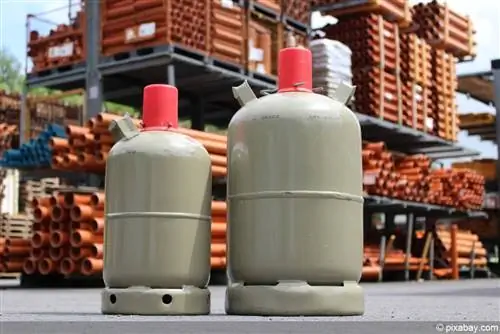
The application is very simple and basically always the same for all flame devices. Nevertheless, there are differences between the individual device types. Below is a general guide to flaming. However, be sure to also pay attention to the manufacturer's information and the operating instructions.
Connect gas bottle/cartridge
In the first step, the device must be connected to a gas bottle or cartridge. Small gas burners can usually be connected directly to a gas cartridge. For larger burners, the gas hose is first connected to the pressure regulator. If a pressure reducer is not integrated into the device, a regulator on the gas bottle is important as it regulates the gas supply. No matter which variant you use, it is always important to check the connections for leaks so that gas does not accidentally leak out in the wrong place.
Light the gas
Not all devices ignite the gas in the same way. Some devices are equipped with automatic ignition (piezoelectric). With other burners, the propane gas must be ignited carefully with a match or lighter (preferably a stick lighter). In this case, the gas tap on the gas bottle is first turned on and then the regulator on the weed burner is set to the lowest level. The control level is only increased if the gas does not ignite at low level.
Flame weeds
As soon as the gas flame is lit, weed control can begin. To flame the weeds between the paving stones, all you have to do is pass the flame directly over the weeds or moss a few times.
Control
In order to work as effectively as possible, the cells of the plants must be destroyed. Heating for too short a time does not damage the cells sufficiently. Heating for too long is not desirable because of the high expenditure of time and money. For this reason, the so-called finger pressure test is the most important control measure when removing weeds. After the heat has been applied, squeeze the leaf, which may still be green, with two fingers. If your fingerprint remains clearly visible, the treatment time, gas pressure and burner setting are sufficient. If the finger sample does not leave a mark on the sheet, it must be treated for longer or the gas pressure must be increased.
Important factors
If you want to remove weeds with an appropriate device, you should pay attention to a few important things that can have a particularly big influence on success.
Effect Radius
With a flame device you can only destroy the above-ground parts of the plant. However, the roots of the corresponding plants remain undamaged in the soil and can sprout again after some time. In many cases it is therefore necessary to either burn the roots several times every two weeks or, alternatively, remove the roots by hand. The smaller and younger the unwanted weeds are, the more effective the method is.
Type of weed
As a rule, seed weeds are very sensitive to heat, especially in the early stages of development (up to four leaves). Weeds with leathery or hairy surfaces, on the other hand, can withstand a lot of heat. In the case of grasses, the vegetation point is in the ground and is therefore quite well protected. That's why they sprout again quite quickly after being flamed. Larger plants should be removed mechanically in advance. Are less sensitive to heat:
- Stinging Nettle (Urtica)
- Thistle
- Purslane (Portulaca)
- Swamp cress (Rorippa)
- Sock dock (Rumex otusifolius)
- Queengrass (Elymus)
- Annual bluegrass (Poa annua)
Tip:
For grasses and other well-rooted plants, it is helpful to repeat the flaming process after two weeks.
Weather conditions
The smaller and drier the plants are, the more effective the shock-like heat of the flame device is. Moisture or dew drops on the leaves delay the effect of heat on the cells. Depending on the device variant (especially devices that are open at the side), the effect in windy conditions is severely limited. Favorable conditions:
- dry weather
- little wind
- preferably work on hot days
- do not flame early in the morning or late in the evening
Advantages of the method
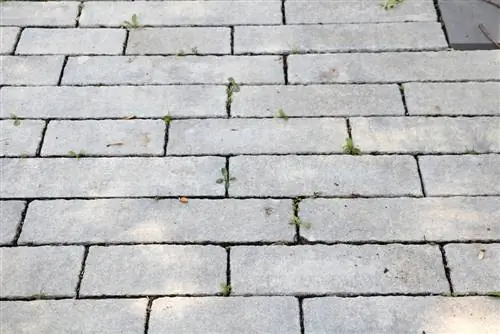
Flaming weeds offers a number of advantages as it is an effective thermal method of weed destruction.
Fast and effective
It is very difficult to remove the weeds in the joints between the stone slabs by hand. By scarfing with a suitable device, this process can be carried out in a shorter time. Under optimal conditions the efficiency is 100%.
Environmentally friendly
The burning method does not use any chemicals or other substances such as s alt or vinegar that could endanger the soil and groundwater. No residue remains.
Non-toxic
In this type of weed control, only liquid gas is burned, so that other than water and carbon dioxide, no other compounds are usually formed. There is no risk to he alth if touched or swallowed by animals or small children.
Biologically harmless
Flaming devices are preferred when an area is managed according to biological (ecological) aspects. With the necessary care and precautions, vegetable beds can also be treated.
Practical and back-friendly
Flaming devices for household use are designed so that they can easily be operated while standing. So a kneeling position for hours is not necessary.
Disadvantages
Deleting weeds by burning them doesn't just have advantages. Disadvantages include:
- relatively high energy consumption
- high carbon dioxide emissions over large areas
- Caution is required when handling gas and open flames
- Beneficial insects in the soil can be endangered (only in the top layer of soil)
Tip:
If you burn the weeds in warm, dry weather, fewer beneficial insects will be close to the surface at this time. Because of the unfavorable conditions, they retreat to deeper levels. This means they are less at risk.
Various models
Whether and which flame burning device is suitable for use on your own property is usually a question of the area on which the weeds are to be flamed down.
Mobile flame burners with cartridge
Weed burners that operate with a gas cartridge are only suitable for small areas. Due to the size of the burner and the limited amount of gas in the cartridge, large-area flame-burning is not possible. However, this variant allows you to work more precisely. The flame temperature is slightly lower than with large devices, but it is sufficient to destroy the weeds.
Large, powerful devices with gas bottles
The variants with a gas bottle are better suited for burning weeds over large areas. The devices themselves are a little more expensive and you also have to get the propane gas bottle and move it around the property.
In principle:
The larger the area, the more likely it is to use powerful flame burners with large gas bottles. The smaller devices are usually sold as a complete set, i.e. with a burner and a smaller gas cartridge. For larger devices, you can usually buy the burner part including a five meter gas hose. The gas bottle and possibly the pressure reducer must be purchased separately.
Powered burners
If burning weeds with a gas burner seems too dangerous, you can also use weed burners that are powered by electricity. Gas-powered flame burners operate at higher temperatures, making them more effective. Good flame burners powered by electricity achieve a heat beam of around 650 degrees. At this temperature, the unwanted weed between the joints can be removed almost like with a conventional flamer. However, it must be taken into account that completely destroying the weeds may take a little longer.
Conclusion
The few legally permitted methods against weeds on paved surfaces and sidewalks include, in addition to mechanical methods, only thermal methods such as flaming. Weed removal is a very effective and environmentally friendly method. However, only if certain rules of the game are adhered to. The drier and smaller the unwanted weeds are, the more effective this type of weed destruction is.

